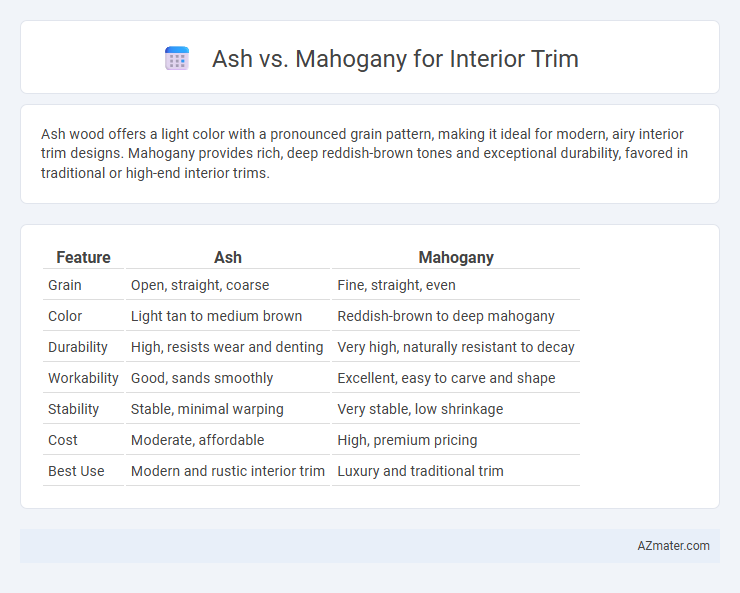Ash wood offers a light color with a pronounced grain pattern, making it ideal for modern, airy interior trim designs. Mahogany provides rich, deep reddish-brown tones and exceptional durability, favored in traditional or high-end interior trims.
Table of Comparison
| Feature | Ash | Mahogany |
|---|---|---|
| Grain | Open, straight, coarse | Fine, straight, even |
| Color | Light tan to medium brown | Reddish-brown to deep mahogany |
| Durability | High, resists wear and denting | Very high, naturally resistant to decay |
| Workability | Good, sands smoothly | Excellent, easy to carve and shape |
| Stability | Stable, minimal warping | Very stable, low shrinkage |
| Cost | Moderate, affordable | High, premium pricing |
| Best Use | Modern and rustic interior trim | Luxury and traditional trim |
Introduction to Ash and Mahogany for Interior Trim
Ash and mahogany are popular hardwoods commonly used for interior trim due to their durability and aesthetic appeal. Ash features a light color with prominent grain patterns, offering a natural, bright look, while mahogany boasts a rich, deep reddish-brown hue known for its elegance and warmth. Both materials provide excellent machinability and finishing properties, making them ideal for detailed interior trim work.
Characteristics of Ash Wood
Ash wood is prized for its light color, straight grain, and excellent workability, making it a favored choice for interior trim that requires both strength and aesthetic appeal. Its natural durability and resistance to wear ensure longevity in high-traffic areas, while the smooth texture accepts stains and finishes well, allowing for versatile design options. Compared to mahogany, ash offers a brighter, more contemporary look with a slightly coarser grain, ideal for those seeking a modern yet durable wood trim.
Characteristics of Mahogany Wood
Mahogany wood features a rich reddish-brown hue with a smooth, fine grain that enhances the elegance of interior trim. It offers excellent durability and resistance to warping, making it ideal for moldings, baseboards, and door frames. Known for its workability and ability to take stain evenly, mahogany ensures a luxurious, long-lasting finish that complements both traditional and modern interiors.
Color and Grain Comparison
Ash wood features a light beige to pale brown color with pronounced, straight grain patterns that enhance a modern or rustic interior trim. Mahogany exhibits a rich reddish-brown to deep chestnut hue with a fine, straight grain that offers a more traditional and elegant appearance for trim work. Both woods provide durability but the color depth and grain distinctiveness make ash ideal for brighter, contemporary spaces, while mahogany suits warm, classic designs.
Durability and Longevity
Ash offers excellent durability and resistance to wear, making it ideal for high-traffic interior trim applications, with a hardness rating of around 1320 on the Janka scale. Mahogany, known for its rich color and natural oils, provides moderate durability but excels in longevity due to its resistance to decay and insect damage. Both woods maintain their structural integrity over time, but ash typically withstands physical impact better, while mahogany offers superior resistance to environmental factors.
Maintenance and Care Requirements
Ash offers moderate maintenance with its open grain structure, requiring regular sealing or finishing to prevent moisture damage and staining, making it ideal for interior trim in controlled environments. Mahogany offers superior durability and natural resistance to decay and insects, demanding less frequent upkeep and only occasional polishing to maintain its rich color and smooth surface. Both woods benefit from dusting and cleaning with a soft cloth, but mahogany's stability reduces the risk of warping or cracking compared to ash in fluctuating humidity conditions.
Cost Differences and Budget Considerations
Ash offers a more cost-effective option for interior trim due to its widespread availability and faster growth rate, resulting in lower material prices compared to mahogany. Mahogany, known for its rich color and durability, commands a higher price point that can significantly impact budget allocations in high-end projects. Homeowners and designers should balance aesthetic preferences with budget constraints, as choosing ash allows for more extensive trim work without compromising overall project costs.
Environmental Impact and Sustainability
Ash and mahogany differ significantly in environmental impact and sustainability for interior trim; ash is generally sourced from faster-growing, more abundant species, making it a more renewable and eco-friendly choice. Mahogany, often harvested from slow-growing tropical forests, raises concerns about deforestation and illegal logging, though certified sustainable mahogany options are available. Choosing ash contributes to lower carbon footprints in interior design due to its rapid renewability and less-intensive harvesting practices.
Design Styles and Applications
Ash wood's light color and pronounced grain make it ideal for modern and Scandinavian interior trim, enhancing clean lines and minimalist aesthetics. Mahogany, with its rich reddish-brown hue and smooth texture, complements traditional, colonial, and classic design styles, adding warmth and sophistication to moldings and baseboards. Both woods offer durability, but ash suits brighter, airier spaces while mahogany excels in creating elegant, timeless trim accents.
Choosing the Right Wood for Your Interior Trim
Ash offers a light, airy grain with excellent durability, making it ideal for modern and rustic interior trim designs that require strength and a natural look. Mahogany provides a rich, deep reddish-brown hue and fine grain, favored for classic, elegant interiors where warmth and luxury are desired. Selecting the right wood depends on your stylistic preference, budget, and the room's exposure to wear and tear, with ash being more affordable and resilient, while mahogany commands higher cost but delivers unmatched sophistication.

Infographic: Ash vs Mahogany for Interior Trim
 azmater.com
azmater.com